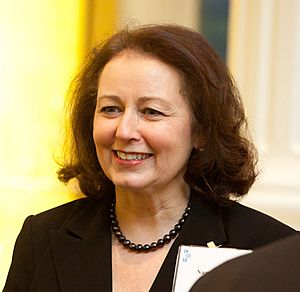Nancy B. Jackson facts for kids
Quick facts for kids
Nancy B. Jackson
|
|
|---|---|

Jackson in 2011
|
|
| Born | March 1, 1956 |
| Died | January 3, 2022 (aged 65) |
| Nationality | American |
| Alma mater | George Washington University, University of Texas at Austin |
| Awards | AAAS Award for Science Diplomacy, (2012) |
| Scientific career | |
| Fields | Alternative fuels, safety |
| Institutions | Sandia National Laboratories |
| Thesis | CO hydrogenation over zirconia-based metal oxides (1990) |
| Doctoral advisor | John G. Ekerdt |
Nancy Beth Jackson (March 1, 1956 – January 3, 2022) was an American chemist. She was a leader in energy research. Her work focused on finding new ways to create energy. She also worked to make sure chemicals were used safely. This helped prevent them from being used for bad purposes. Nancy Jackson was a big supporter of getting more diverse people into science, technology, engineering, and math (STEM) careers. In 2011, she was the president of the American Chemical Society. This was during the International Year of Chemistry. She received an award for her work in science diplomacy in 2012.
Contents
Early Life and Education
Nancy Jackson was born on March 1, 1956. Her hometown was Eau Claire, Wisconsin. Her father was from the Seneca people. Her mother was Caucasian. Both of her parents were ministers. Also, both of her grandmothers had master's degrees. One of her grandfathers came from the Cattaraugus Reservation in New York.
Nancy first studied political science at college. But she soon became very interested in science. She earned a bachelor's degree in chemistry in 1979. This was from George Washington University. After working briefly, she went back to school. She studied at the University of Texas at Austin. She earned two more degrees there. She got a master's degree in chemical engineering in 1986. Then, she got her Ph.D. in chemical engineering in 1990. Her advanced studies focused on catalysis. This is about how to speed up chemical reactions.
Career in Science
In 1991, Nancy Jackson joined Sandia National Laboratories. This lab is in Albuquerque, New Mexico. She worked there as an energy researcher for many years. She focused on new energy sources. These included solar fuel. She studied how to make liquid fuels from things other than oil. This involved finding special materials called catalysts. In 1999, she also became a research professor. She taught at the University of New Mexico.
From 2000 to 2004, Nancy managed a department at Sandia. This group worked on chemical and biological imaging. They used special cameras to see chemicals. This helped them understand materials better.
Promoting Chemical Safety Globally
In 2007, Nancy started a new department at Sandia. It was called the International Chemical Threat Reduction Department. She was the first person to work with the United States Department of State. Together, they created the Chemical Security Engagement Program. This program teaches people around the world about chemical safety. It helps prevent chemicals from being misused. Nancy traveled a lot for this work. She visited many countries in Asia, the Middle East, and North Africa.
Supporting Diversity in STEM
Nancy Jackson strongly supported diversity in STEM fields. STEM stands for science, technology, engineering, and math. She was a member of the American Indian Science and Engineering Society. She also helped Sandia National Laboratories work with Native American tribal governments. She helped create a STEM program for minority students. This program was called the Science and Technology Alliance. Nancy also worked hard to support women in STEM careers.
Leadership in Chemistry
Nancy Jackson was a Fellow of several important science groups. These included the American Chemical Society. In 2009, she was chosen to be a future president of the American Chemical Society. She served as president in 2011. This was during the United Nations' International Year of Chemistry. During her time as president, she worked to increase international cooperation. She visited over 20 countries. She met with many chemists and chemical engineers. Many of them were women.
In 2012, she received a special award. It was the AAAS Award for Science Diplomacy. She got this award for her work in international science cooperation. This included her efforts to prevent chemical misuse. She also helped develop and support the careers of scientists worldwide. She especially focused on women scientists in the Middle East and Southeast Asia.
Personal Life and Legacy
Nancy Jackson passed away on January 3, 2022. She was 65 years old. She died in Albuquerque, New Mexico. She is remembered for her important work in energy, chemical safety, and promoting diversity in science. She was survived by her husband and their two sons.
Awards and Honors
- 2014–15: Sylvia M. Stoesser Lecturer in Chemistry at the University of Illinois
- 2012: AAAS Award for Science Diplomacy
- 2011: President of the American Chemical Society
- 2011: Distinguished Women in Chemistry and Chemical Engineering Award
- 2009: Howard Fawcett Chemical Health & Safety Award
- 2005: American Indian Science and Engineering Society (AISES) Professional of the Year award
- 2005: Distinguished Alumni Achievement Award, George Washington University

